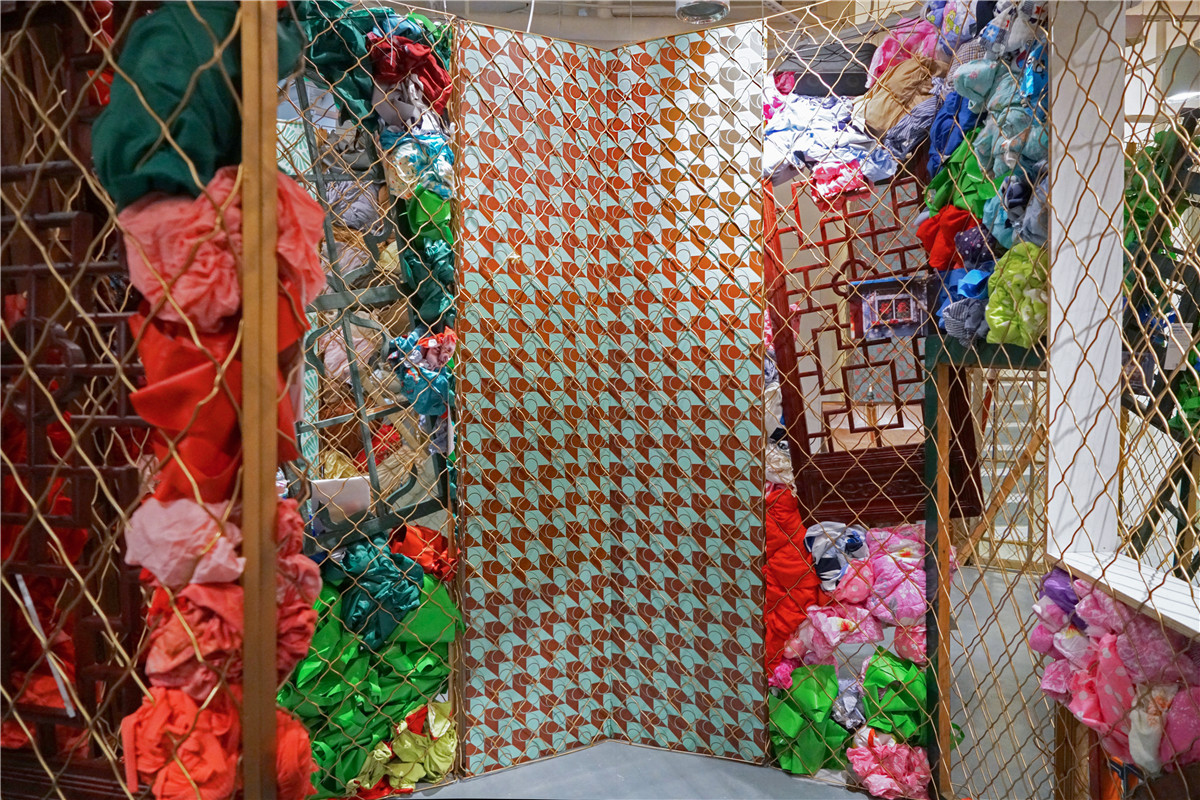构思在北京,制作在广州,展示在香港。这三座城市所代表的,也是“填迷墙”所表现出当代中国最突出的特征——剧变。
Waste from Beijing where the design of Stuff Wall is conceived, Guangzhou where it is produced, and Hong Kong where it is exhibited. These three cities represent the tumultuous change that characterizes contemporary China.
“填迷墙”的灵感,来自北京老城区常见的防盗金属网。防盗网本是用来隔绝不速之客的,却意外地变成日常生活的储物空间。在蜿蜒狭长的老城区胡同里,只有通过这些装着防盗网的窗户,才透露出一点住在绵长砖墙之后人们的生活细节。
Stuff Wall is inspired by metal security screens commonly attached to homes in old Beijing neighborhoods. Originally designed to keep out unwanted guests, the screens inadvertently become spaces for storing stuff. In these neighborhoods of winding alleys called hutongs, only security screen windows hint at the lives of people on the other side of long brick walls.
“填迷墙“将北京胡同那迷宫般的狭窄巷道,搬到了香港的K11艺术空间。在以防盗网围成的迷宫墙壁里,填充着来自北京、广州、香港三地的废弃物品。”填迷墙“构思在北京,制作在广州,展示在香港。这三座城市所代表的,正是当代中国最突出的特征——剧变。
Stuff Wall transposes the narrow labyrinthine streets of Beijing hutongs to K11 Art Space in Hong Kong. Contained within the security screen walls of this maze is waste from Beijing where the design of Stuff Wall is conceived, Guangzhou where it is produced, and Hong Kong where it is exhibited. These three cities represent the tumultuous change that characterizes contemporary China.
每件废品的背后都有一个故事。在北京——这个国家的文化中心,我们从老街区搜集了被拆除四合院房屋的残片,但那仅是每天大量拆除房屋的冰山一角;在广州——中国这个“世界工厂”的制造业中心,我们从服装厂收集到大量新衣生产过程中的边角料;而在香港——全球消费之都,我们则从露天市场和小摊上找来二手旧物。
There is a story behind each piece of waste. In Beijing, the nation’s cultural center, we collected remnants of torn down traditional courtyard houses from historic neighborhoods, just a small sample of the buildings demolished on a daily basis. In Guangzhou, a manufacturing powerhouse in the world’s factory, we gathered massive amounts of leftover fabric from the production of new clothing in garment factories. And in Hong Kong, a global capital of consumption, we looked for used goods from street markets and stalls.
当观众在“填迷墙”里寻找出路时,周围高耸的填料逐渐变得低矮,那些纵横交错的通道慢慢露出全貌,好似在传统迷宫里获胜者最终到达最高点,迷宫顿时一览无余一般。
As visitors find their way through Stuff Wall the surrounding detritus eventually recedes in elevation to reveal an unfettered view of the traversed path, much like the raised vantage point rewarded to people at the end of a traditional maze.
这组装置位于K11的地下展示空间,当人们进出地铁或商场时就会看到。为鼓励行人参与其间,层层迷宫的墙壁内嵌有一组组窗洞,人们可以透过这些填满物品的屏障,一直看进迷宫的中心。
Located in K11’s underground exhibition space, the installation can be seen by people on their way to the subway or the mall. To encourage passersby to engage with the project, nested windows are cut through the walls of the maze, allowing views through multiple layers of stuffed screens into the heart of the maze.
迷失在“填迷墙”中,人们会遇见那些或新或老的故事。墙中还留出一些空档,鼓励观众来将自己的物品与故事,填入其中。
As guests lose their way in the maze, they will encounter new and old stories. Walls are left partially empty to encourage guests to embed their own belongings and narratives.
▲立面图
▲平面图
▲轴测图
项目信息——
客户:K11
Client:k11
项目地址:香港
Location:Hong Kong
完成时间:2016年11月
Completion:Nov. 2016
面积:230 平米
Area:230 sqm
设计主持:何哲、James Shen(沈海恩)、臧峰
Principal: He Zhe, James Shen, Zang Feng
项目团队:冯紫晴、Pablo Herraiz Garcia de Guadiana(何西王)、魏家晨、张朕
Project Team: Feng Ziqing, Pablo Herraiz Garcia de Guadiana, Wei Jiachen, Zhang Zhen
摄影:众建筑
Photographer: People’s Architecture Office
腾讯视频链:https://v.qq.com/x/page/h03671jui49.html
Video Link: https://vimeo.com/199985483
《Hi设计》已获授权,版权归原作者所有,如需转载请注明出处




























